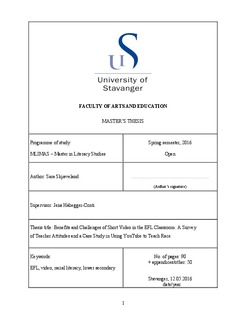| dc.description.abstract | This thesis investigates the use of short videos as pedagogical tools in lower secondary school in Norway. The thesis raises research questions regarding teachers’ use of short video in EFL, teacher and student attitudes to video teaching, and student responses to being taught contemporary race issues through short video.
Data in this study were obtained through mixed method research. Firstly, quantitative data were gathered through an online teacher questionnaire in which 39 lower secondary EFL teachers in the Stavanger area participated. Secondly, a small-scale case study in a tenth grade class measured students’ attitudes to videos and their reaction to being taught contemporary race issues through qualitative methods such as teacher intervention and focus group interviews. The case study involved the researcher teaching three consecutive lessons about race using two types of short videos: two news broadcasts and one documentary.
This study has found that the main intentions that the teachers have when using short videos in EFL teaching are to differentiate their teaching, motivate students, and vary lessons. Content wise, teachers use videos to promote cultural insight and to expose students to authentic language, with communicative competence, listening comprehension and vocabulary learning as desired learning outcomes.
Among the positive impacts of short videos, teachers have experienced their students being motivated, engaged and remembering content better than through traditional textbook teaching. In addition, teachers report that students who struggle with comprehension benefit from the visual element in a video, thus reinforcing Paivio’s notion that visual stimuli reinforces verbal understanding (Paivio et al. 1980). The most prominent challenges accounted for were the demanding and sometimes inappropriate language of authentic videos found on the Internet, as well as technological issues such as unreliable video presentation tools.
What has come to light in this study is that videos are being used mostly as supplements or illustrations to the textbook with the intention of filling the gap between what the curriculum demands and the textbook offers. This use of videos gives the impression that teachers do not incorporate short videos as texts into the subject syllabus and assessment, thus indicating that many teachers do not regard videos as being of equal educational value as written texts in English teaching.
This study has found that students being familiar with YouTube through home usage brings both benefits and challenges into the EFL classroom. On the one hand, this can lead to higher intrinsic motivation because being able to understand what they are viewing is transferrable to their personal lives. On the other hand, students will often associate YouTube and video viewing in general with entertainment and relaxation, making it challenging for teachers to clearly distinguish educational and recreational use of the resource in their teaching.
The students in this study were mostly positive towards learning with short videos, and believed that they learn more, focus better, and remember content longer by viewing video as opposed to reading written texts in English lessons. The students also indicated that a haphazard use and over- or misuse of video in the classroom results in the teaching tool losing its appeal to them.
The students reported that being taught race through the news and documentary in the case study provided them with new perspectives on race issues. The student responses indicated that a combination of representing race from the perspective of the past and present, as well as incorporating several viewpoints, first-hand experiences, and relating issues to their own lives are effective approaches to teaching race.
In view of the results of this research, videos have promising potential for teaching race that goes beyond the English subject as the combination of communicative competence obtained from viewing authentic video and the cultural competence gained through learning about race stretches far in meeting the Core Curriculum’s ideals of democratic involvement and co-citizenship. This study has contributed to create an awareness of the need for more teacher training in new forms of literacy and raised some interesting questions about the implications of teaching contemporary race issues in Norway. | nb_NO |

